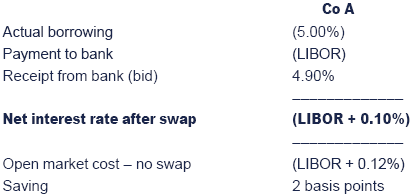Interest rate SWAPs
Interest rate swaps are a tool for hedging interest rate risk.
Characteristics
An interest rate swap is an agreement whereby the parties agree to swap a floating stream of interest payments for a fixed stream of interest payments and via versa. There is no exchange of principal:
- The companies involved are termed 'counter-parties'.
- Swaps can run for up to 30 years.
- Swaps can be used to hedge against an adverse movement in interest rates. Say a company has a $200m floating loan and the treasurer believes that interest rates are likely to rise over the next five years. He could enter into a five-year swap with a counter party to swap into a fixed rate of interest for the next five years. From year six onwards, the company will once again pay a floating rate of interest.
- A swap can be used to obtain cheaper finance. A swap should result in a company being able to borrow what they want at a better rate under a swap arrangement, than borrowing it directly themselves.
Calculations based on splitting gains
The precise details of the swap arrangement will depend on how the potential gains are split between the two counter-parties.
Illustration
Company A wishes to raise $10m and to pay interest at a floating rate, as it would like to be able to take advantage of any fall in interest rates. It can borrow for one year at a fixed rate of 10% or at a floating rate of 1% above LIBOR.
Company B also wishes to raise $10m. They would prefer to issue fixed rate debt because they want certainty about their future interest payments, but can only borrow for one year at 13% fixed or LIBOR + 2% floating, as it has a lower credit rating than company A.
Calculate the effective swap rate for each company - assume savings are split equally.
Solution
Step 1: Identify the type of loan with the biggest difference in rates.
Step 2: Identify the party that can borrow this type of loan the cheapest.
- Answer: Company A
- Thus Company A should borrow fixed, company B variable, reflecting their comparative advantages.
Step 3:
- Company A has cheaper borrowing in both fixed and variable. Interest rate differentials are 3% for fixed and 1% for variable. The difference between these (2%) is the potential gain from the swap.
- Splitting this equally between the two counter parties, each should gain by 1%.
One way (there are many!) of achieving this is for A to pay B LIBOR (variable) and for B to pay A 10%.
Summary

Calculations involving quoted rates from intermediaries
In practice a bank normally arranges the swap and will quote the following:
- The 'ask rate' at which the bank is willing to receive a fixed interest cash flow stream in exchange for paying LIBOR.
- The 'bid rate' that they are willing to pay in exchange for receiving LIBOR.
The difference between these gives the bank's profit margin and is usually at least 2 basis points.
Note: LIBOR is the most widely used benchmark or reference rate for short-term interest rates worldwide, although the swap could relate to Euribor, say
Illustration
Co A currently has a 12-month loan at a fixed rate of 5% but would like to swap to variable. It can currently borrow at a variable rate of LIBOR + 12 basis points.
The bank is currently quoting 12-month swap rates of 4.90 (bid) and 4.95 (ask).
Show Co A's financial position if it enters the swap.
Solution

Options over swaps
Swaptions are hybrid derivative products that integrate the benefits of swaps and options. They are options on swaps.
The purchaser of an interest rate swaption has the right, but not the obligation, to enter into an interest rate swap at some future date on terms agreed today. An up front premium is payable
|
Created at 9/12/2012 4:07 PM by System Account
(GMT) Greenwich Mean Time : Dublin, Edinburgh, Lisbon, London
|
Last modified at 11/13/2012 3:56 PM by System Account
(GMT) Greenwich Mean Time : Dublin, Edinburgh, Lisbon, London
|
|
|
|
 |
Rating
:
|
 Ratings & Comments
(Click the stars to rate the page) Ratings & Comments
(Click the stars to rate the page)
|
 |
Tags:
|
|
|
|
|